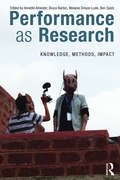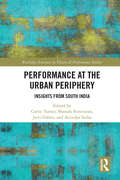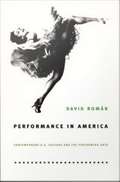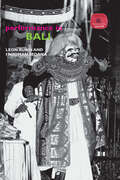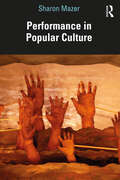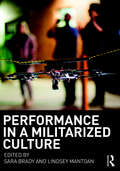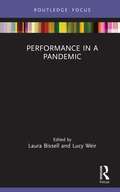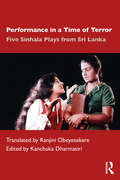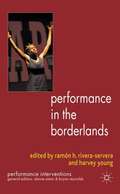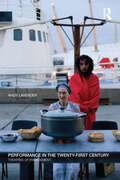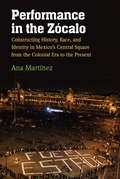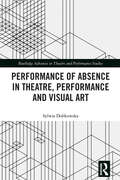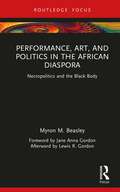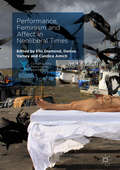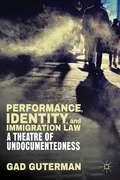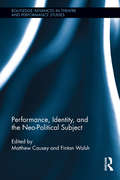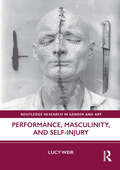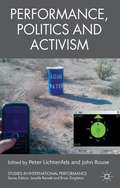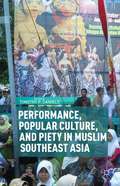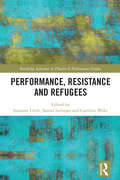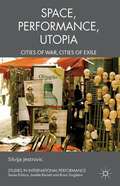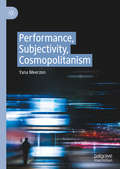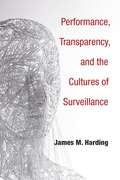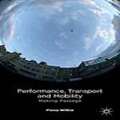- Table View
- List View
Performance as Research: Knowledge, methods, impact
by Bruce Barton Annette Arlander Melanie Dreyer-Lude Ben SpatzPerformance as Research (PAR) is characterised by an extraordinary elasticity and interdisciplinary drive. Performance as Research: Knowledge, Methods, Impact celebrates this energy, bringing together chapters from a wide range of disciplines and eight different countries. This volume focuses explicitly on three critical, often contentious themes that run through much discussion of PaR as a discipline: Knowledge - the areas and manners in which performance can generate knowledge Methods - methods and methodologies for approaching performance as research Impact - a broad understanding of the impact of this form of research These themes are framed by four essays from the book's editors, contextualising their interrelated conversations, teasing out common threads, and exploring the new questions that the contributions pose to the field of performance. As both an intervention into and extension of current debates, this is a vital collection for any reader concerned with the value and legitimacy of performance as research.
Performance at the Urban Periphery: Insights from South India (Routledge Advances in Theatre & Performance Studies)
by Anindya Sinha Sharada Srinivasan Jerri Daboo Cathy TurnerThis edited volume considers performance in its engagement with expanding Indian cities, with a particular focus on festivals and performances in Karnataka, Tamil Nadu and Kerala. The editors ask how performance practices are affected by urbanisation, the effects of such changes on their cultural economy, and the environmental impacts of performance itself. This project also considers how performance responds to its context, and the potential for performance to be critical of the city’s development, and of its own compromises. Bringing together perspectives from the humanities, natural and social sciences, the book takes a multi-faceted analytical view of live performance, connecting contemporary with heritage forms, and human with more-than-human actors. The three sections, themed around heritage, everyday life, and future ecologies, will be of great interest to students and scholars in performance, heritage studies, ecology and art history.
Performance in America: Contemporary U.S. Culture and the Performing Arts
by David RománPerformance in America demonstrates the vital importance of the performing arts to contemporary U. S. culture. Looking at a series of specific performances mounted between 1994 and 2004, well-known performance studies scholar David Romn challenges the belief that theatre, dance, and live music are marginal art forms in the United States. He describes the crucial role that the performing arts play in local, regional, and national communities, emphasizing the power of live performance, particularly its immediacy and capacity to create a dialogue between artists and audiences. Romn draws attention to the ways that the performing arts provide unique perspectives on many of the most pressing concerns within American studies: questions about history and politics, citizenship and society, and culture and nation. The performances that Romn analyzes range from localized community-based arts events to full-scale Broadway productions and from the controversial works of established artists such as Tony Kushner to those of emerging artists. Romn considers dances produced by the choreographers Bill T. Jones and Neil Greenberg in the mid-1990s as new aids treatments became available and the aids crisis was reconfigured; a production of the Asian American playwright Chay Yew's A Beautiful Country in a high-school auditorium in Los Angeles's Chinatown; and Latino performer John Leguizamo's one-man Broadway show Freak. He examines the revival of theatrical legacies by female impersonators and the resurgence of cabaret in New York City. Romn also looks at how the performing arts have responded to 9/11, the U. S. invasion of Afghanistan, and the second war in Iraq. Including more than eighty illustrations, Performance in America highlights the dynamic relationships among performance, history, and contemporary culture through which the past is revisited and the future reimagined.
Performance in Bali
by Leon Rubin I. Nyoman SedanaLeon Rubin and I Nyoman Sedana, both international theatre professionals as well as scholars, collaborate to give an understanding of performance culture in Bali from inside and out. The book describes four specific forms of contemporary performance that are unique to Bali: Wayang shadow-puppet theatre Sanghyang ritual trance performance Gambuh classical dance-drama the virtuoso art of Topeng masked theatre. These culturally unique and beautiful theatrical events are contextualised within religious, intellectual and social backgrounds to give unparalleled insight into the mind and world of the Balinese performer.
Performance in Popular Culture
by Sharon MazerPerformance in Popular Culture reveals the intricate relationship between performance and popular culture by exploring how theatrical conventions and dramaturgical tropes have informed the way the social is constructed for popular consumption. Staged as a series of case studies, this book considers the diverse ways the social is imagined and produced in live and mediated performances, in images and texts, in interactive experiences and in cultural institutions. By looking at performance in popular culture, the world we live in becomes more visible, open to investigation and (perhaps) to change. Performance in Popular Culture engages a wide range of disciplines and theoretical frameworks: performance, theatre and cultural studies; comparative literature and media studies; gender and sexuality, critical race and post-colonial theories. Designed for accessibility at an undergraduate level, the case studies make use of visual materials, moving images and texts that are readily available to lecturers and students, to scholars and to the general public.
Performance in a Militarized Culture
by Sara Brady Lindsey MantoanThe long cultural moment that arose in the wake of 9/11 and the conflict in the Middle East has fostered a global wave of surveillance and counterinsurgency. Performance in a Militarized Culture explores the ways in which we experience this new status quo. Addressing the most commonplace of everyday interactions, from mobile phone calls to traffic cameras, this edited collection considers: How militarization appropriates and deploys performance techniques How performing arts practices can confront militarization The long and complex history of militarization How the war on terror has transformed into a values system that prioritizes the military The ways in which performance can be used to secure and maintain power across social strata Performance in a Militarized Culture draws on performances from North, Central, and South America; Europe; the Middle East; and Asia to chronicle a range of experience: from those who live under a daily threat of terrorism, to others who live with a distant, imagined fear of such danger.
Performance in a Pandemic
by Laura BissellThis edited collection gathers UK and international artists, academics, practitioners, and researchers in the fields of contemporary performance, dance, and live art to offer creative-critical responses to the impact of the COVID-19 pandemic on their work. Themes addressed in these case studies include the ways in which liveness functions across digital platforms, the new demands on audiences and performance-makers, and the impact on international festivals as the digital removes geographical and locational restrictions. Brought together, these examples capture the creative activity and output that this unexpected cultural moment has provoked. Creative-critical responses interrogate what the global pandemic has taught us about what it is to make live work during lockdown and explore what the future of performance-making in a post-COVID world might look like. For all scholars and performance-makers whose work brings them into the sphere of contemporary art and culture, this is an essential and stimulating account of practice at the beginning of the 2020s.
Performance in a Time of Terror: Five Sinhala Plays from Sri Lanka
by Ranjini Obeyesekere Kanchuka DharmasiriThis volume is a collection of five Sinhala plays, translated into English, which were written and performed during the most violent phase of modern Sri Lankan history. Ranjini Obeyesekere’s translation of these five well-known and celebrated plays by K. B. Herath, Prasannajith Abeysuriya, Dhananjaya Karunarathne, Prasanna Jayakody and Rajitha Dissanayake highlights and explores the dynamic period of Sri Lankan theater and performance arts in the 1980s and 1990s. The plays in this collection offered a political space for criticism, introspection, discussion and protest during a time of suppression of voices, political violence and terror. Audiences flocked to the theater to watch plays produced by talented dramatists and artists who were experimenting with forms and themes under extremely challenging circumstances, shoe-string budgets and strict censorship. Kanchuka Dharmasiri’s introduction to the volume further details the history and socio-political contexts of the theater of this period, discussing themes such as dissent, identity and the brutal power of the state. She also looks at the unique formal elements employed in these plays as well as their influence and reach. This volume is a significant addition to the growing corpus of Sinhala literature in translation. It will be an essential read for scholars and researchers of literature, performance studies, cultural studies, and the politics and history of Sri Lanka.
Performance in the Borderlands
by Emelyne GodfreyA border is a force of containment that inspires dreams of being overcome and crossed; motivates bodies to climb over; and threatens physical harm. This book critically examines a range of cultural performances produced in relation to the tensions and movements of/about the borders dividing North America, including the Caribbean.
Performance in the Field: Interdisciplinary Practice-as-Research
by David OverendThis book makes a compelling case for ‘performance fieldwork’ as a vital new approach to interdisciplinary collaboration. Refocussing the histories and practices of field research, it shows how creative methods and artistic processes can contribute to an embodied and situated knowledge of complex landscapes and environments. The book brings together case studies of innovative research in the fields of ecology, clubbing, heritage, mobility and deep time, which took place in the United Kingdom between 2009 and 2021. These accessible and engaging field notes connect to international and intercultural contexts, with attention to alternative experiences and perspectives throughout. Together, they provide a critically informed ‘toolbox’ of playful and exploratory strategies for working with a diverse range of urban and rural sites – including a river, a museum, a nightclub, a motorway and a cave. This is a timely methodology that reaches across disciplines to demonstrate how performance continually plays out ‘in the field’.
Performance in the Twenty-First Century: Theatres of Engagement
by Andy LavenderPerformance in the Twenty-First Century: Theatres of Engagement addresses the reshaping of theatre and performance after postmodernism. Andy Lavender argues provocatively that after the ‘classic’ postmodern tropes of detachment, irony, and contingency, performance in the twenty-first century engages more overtly with meaning, politics and society. It involves a newly pronounced form of personal experience, often implicating the body and/or one’s sense of self. This volume examines a range of performance events, including work by both emergent and internationally significant companies and artists such as Rimini Protokoll, Blast Theory, dreamthinkspeak, Zecora Ura, Punchdrunk, Ontroerend Goed, Kris Verdonck, Dries Verhoeven, Rabih Mroué, Derren Brown and David Blaine. It also considers a wider range of cultural phenomena such as online social networking, sports events, installations, games-based work and theme parks, where principles of performance are in play. Performance in the Twenty-First Century is a compelling and provocative resource for anybody interested in discovering how performance theory can be applied to cutting-edge culture, and indeed the world around them.
Performance in the Zócalo: Constructing History, Race, and Identity in Mexico's Central Square from the Colonial Era to the Present
by Ana MartínezFor more than five centuries, the Plaza Mayor (or Zócalo) in Mexico City has been the site of performances for a public spectatorship. During the period of colonial rule, performances designed to ensure loyalty to the Spanish monarchy were staged there, but over time, these displays gave way to staged demonstrations of resistance. Today, the Zócalo is a site for both official government-sponsored celebrations and performances that challenge the state. Performance in the Zócalo examines the ways that this city square has achieved symbolic significance over the centuries, and how national, ethnic, and racial identity has been performed there. A saying in Mexico City is “quien domina el centro, domina el país” (whoever dominates the center, dominates the country) as the Zócalo continues to act as the performative embodiment of Mexican society. This book highlights how particular performances build upon each other by recycling past architectures and performative practices for new purposes. Ana Martínez discusses the singular role of collective memory in creating meaning through space and landmarks, providing a new perspective and further insight into the problem of Mexico’s relationship with its own past. Rather than merely describe the commemorations, she traces the relationship between space and the invention of a Mexican imaginary. She also explores how indigenous communities, Mexico’s alienated subalterns, performed as exploited objects, exotic characters, and subjects with agency. The book’s dual purposes are to examine the Zócalo as Mexico’s central site of performance and to unmask, without homogenizing, the official discourse regarding Mexico’s natives. This book will be of interest for students and scholars in theater studies, Mexican Studies, Cultural Geography, Latinx and Latin American Studies.
Performance of Absence in Theatre, Performance and Visual Art (Routledge Advances in Theatre & Performance Studies)
by Sylwia DobkowskaThis research project investigates the concepts of absence across the disciplines of visual art, theatre, and performance. Absence in the centre of an ideology frees the reader from the dominant meaning. The book encourages active engagement with theatre theory and performances. Reconsideration of theories and experiences changes the way we engage with performances, as well as social relations and traditions outside of theatre. Sylwia Dobkowska examines and theorises absence and presence through theatre, performance, and visual arts practices. This book will be of great interest to students and scholars of theatre, visual art and philosophy.
Performance, Art, and Politics in the African Diaspora: Necropolitics and the Black Body (Routledge Focus on Art History and Visual Studies)
by Myron BeasleyThis book examines necropolitics and performance art, with a particular focus on the black body and the African diaspora. In the book, Myron Beasley situates artists as cultural workers and theorists who illuminate the political linkages between their own and others’ specific locales. The focus is an interrogation of the political systems that dictate and determine the value of lives (and decide which lives matter) through a lens of performance and art. Beasley highlights how the performances of rupture, which are of artistic, and historical significance, reveal both strategies of survival and promises of possibility. Artists and curators examined include Jelili Atiku, Giscard Bouchotte, Nona Faustine, Vanessa German, Simone Leigh, Nathalie Anguezomo Mba Bikoro, Ebony Patterson, and Dianne Smith. The volume is an ideal research and reference book for students and scholars of Contemporary Art, African Studies, and Performance Theory.
Performance, Feminism and Affect in Neoliberal Times (Contemporary Performance InterActions)
by Elin Diamond Denise Varney Candice AmichThis book is a provocative new study of global feminist activism that opposes neoliberal regimes across several sites including Asia, Australia, Canada, Europe, Latin America and the United States. The feminist performative acts featured in the book contest the aggressive unravelling of collectively won gains in gender, sexual and racial equality, the appearance of new planes of discrimination, and the social consequences of political economies based on free market ideology. The investigations of affect theory follow the circulation of intensities – of political impingements on bodies, subjective and symbolic violence, and the shock of dispossession – within and beyond individuals to the social and political sphere. Affect is a helpful matrix for discussing the volatile interactivity between performer and spectator, whether live or technologically mediated. Contending that there is no activism without affect, the collection brings back to the table the activist and hopeful potential of feminism.
Performance, Identity, and Immigration Law
by Gad GutermanHow has contemporary American theatre presented so-called undocumented immigrants? Placing theatre artists and their work within a context of on-going debate, Guterman shows how theatre fills an essential role in a critical conversation by exploring the powerful ways in which legal labels affect and change us.
Performance, Identity, and the Neo-Political Subject (Routledge Advances in Theatre & Performance Studies #28)
by Matthew Causey Fintan WalshThis book stages a timely discussion about the centrality of identity politics to theatre and performance studies. It acknowledges the important close relationship between the discourses and practices historically while maintaining that theatre and performance can enlighten ways of being with others that are not limited by conventional identitarian languages. The essays engage contemporary theatre and performance practices that pose challenging questions about identity, as well as subjectivity, relationality, and the politics of aesthetics, responding to neo-liberal constructions and exploitations of identity by seeking to discern, describe, or imagine a new political subject. Chapters by leading international scholars look to visual arts practice, digital culture, music, public events, experimental theatre, and performance to investigate questions about representation, metaphysics, and politics. The collections seeks to foreground shared, universalist connections that unite rather than divide, visiting metaphysical questions of being and becoming, and the possibilities of producing alternate realities and relationalities. The book asks what is at stake in thinking about a subject, a time, a place, and a performing arts practice that would come ‘after’ identity, and explores how theatre and performance pose and interrogate these questions.
Performance, Masculinity, and Self-Injury (Routledge Research in Gender and Art)
by Lucy WeirThis book is an ambitious and expansive examination of the visual language of self-injury in performance art from the 1960s to the present.Inspired by the gendered nature of discussion around self-harm, the book challenges established readings of risk-taking and self-injury in global performance practice. The interdisciplinary methodology draws from art history and sociology to provide a new critical analysis of the relationship between masculinity and self-inflicted injury. Based upon interviews with a range of artists around the world, it offers an innovative understanding of the diverse meanings behind self-injury in performance, and delves into the gendered coding of self-harming bodies. Individual chapters examine the work of Ron Athey, Günter Brus, Wafaa Bilal, Franko B, André Stitt, Pyotr Pavlensky, and Yang Zhichao, offering a new perspective on the forms and functions of self-injury in performance art.The book will be of interest to scholars working in art history, performance studies, gender studies, and cultural studies.
Performance, Politics and Activism
by John Rouse Peter LichtenfelsThis collection of essays on politics, the performing arts, and various forms of activist performance uses the framework of performance studies to explore the engagements of political resistance, public practice and performance media. It places these engagements on various scales of performance production within local, national and transnational structures of neoliberal and liberal government and power. Performance has always been a way of articulating the conditions of contemporary society, and of pointing through the body of the performance to ways of defining, understanding and changing those conditions. Throughout these essays performance takes place in the environments of heightened everyday action, the aesthetic and cultural activity of the performing arts, and in the activist performance of political commitment. These trajectories in performance studies delineate the way people identify themselves and communicate with one another, both in attempts to change the structures of governance they experience, and vitally, alongside those structures.
Performance, Popular Culture, and Piety in Muslim Southeast Asia
by Timothy P. DanielsThe Muslim-majority nations of Malaysia and Indonesia are known for their extraordinary arts and Islamic revival movements. This collection provides an extensive view of dance, music, television series, and film in rural, urban, and mass-mediated contexts and how pious Islamic discourses are encoded and embodied in these public cultural forms.
Performance, Resistance and Refugees (Routledge Advances in Theatre & Performance Studies)
by Suzanne Little Samid Suliman Caroline WakeThis book offers a unique Australian perspective on the global crisis in refugee protection. Using performance as both an object and a lens, this volume explores the politics and aesthetics of migration control, border security and refugee resistance. The first half of the book, titled On Stage, examines performance objects such as verbatim and documentary plays, children’s theatre, immersive performance, slam poetry, video art and feature films. Specifically, it considers how refugees, and their artistic collaborators, assert their individuality, agency and authority as well as their resistance to cruel policies like offshore processing through performance. The second half of the book, titled Off Stage, employs performance as a lens to analyse the wider field of refugee politics, including the relationship between forced migrants and the forced displacement of First Nations peoples that underpins the settler-colonial state, philosophies of cosmopolitanism, the role of the canon in art history and the spectacle of bordering practices. In doing so, it illuminates the strategic performativity—and nonperformativity—of the law, philosophy, the state and the academy more broadly in the exclusion and control of refugees. Taken together, the chapters in this volume draw on, and contribute to, a wide range of disciplines including theatre and performance studies, cultural studies, border studies and forced migration studies, and will be of great interest to students and scholars in all four fields.
Performance, Space, Utopia
by Silvija JestrovicThe war in the Balkans that took place between 1991-1995 forms the context of this book. It has been variously viewed as ethnic strife, religious conflict, or civil war but seldom has it been described as a war against cities. Belgrade and Sarajevo offer a fascinating comparative case study, not only because the two cities belong to the same historical narrative of the breakdown of Yugoslavia, but because of the ways in which their various performances both complement and contradict one another. This book examines how performance and theatricality became modes of being and acting in the city, even strategies of physical and ethical survival; yet so often it is exile, both as marginalisation within and exodus from the city, that emerges as the defining consequence of living in Sarajevo or Belgrade in the 1990s.
Performance, Subjectivity, Cosmopolitanism
by Yana MeerzonThis book looks at the connection between contemporary theatre practices and cosmopolitanism, a philosophical condition of social behaviour based on our responsibility, respect, and healthy curiosity to the other. Advocating for cosmopolitanism has become a necessity in a world defined by global wars, mass migration, and rise of nationalism. Using empathy, affect, and telling personal stories of displacement through embodied encounter between the actor and their audience, performance arts can serve as a training ground for this social behavior. In the centre of this encounter is a new cosmopolitan: a person of divided origins and cultural heritage, someone who speaks many languages and claims different countries as their place of belonging. The book examines how European and North American theatres stage this divided subjectivity: both from within, the way we tell stories about ourselves to others, and from without, through the stories the others tell about us.
Performance, Transparency, and the Cultures of Surveillance
by James M. HardingPlacing the disciplines of performance studies and surveillance studies in a timely critical dialogue, Performance, Transparency, and the Cultures of Surveillance not only theorizes how surveillance performs but also how the technologies and corresponding cultures of surveillance alter the performance of everyday life. This exploration draws upon a rich array of examples from theatre, performance, and the arts, all of which provide vivid illustration of the book’s central argument: that the rise of the surveillance society coincides with a profound collapse of democratic oversight and transparency—a collapse that, in turn, demands a radical rethinking of how performance practitioners conceptualize art and its political efficacy. The book thus makes the case that artists and critics must reexamine—indeed, must radically redefine—their notions of performance if they are to mount any meaningful counter to the increasingly invasive surveillance society.
Performance, Transport and Mobility
by Fiona WilkiePerformance, Transport and Mobility is an investigation into how performance moves, how it engages with ideas about movement, and how it potentially shapes our experiences of movement. In a world of apparently global flows of people, goods and ideas, what other stories of travel are told through performance? Using a critical framework drawn from the 'mobility turn' in the social sciences, Fiona Wilkie analyses a wide range of works from scripted plays to site-specific performances, from large-scale festivals to low-key private journeys, and from walking art to Motown music. Along the way, she examines discussions and documents of travel by foot, train, car, boat and plane to create a rich sense of historical and cultural context. In arguing for the capacity of theatre and art to make passage, Wilkie charts a compelling conversation about performance on the move and illuminates a set of practices that explore and challenge what it means to be in transit.
